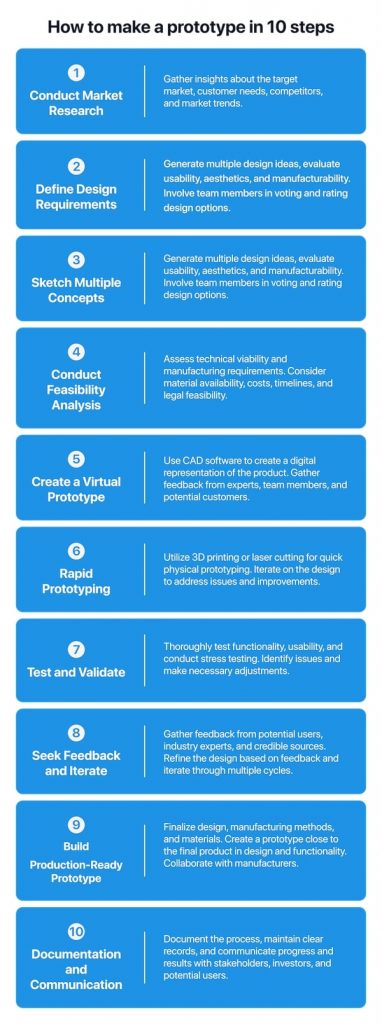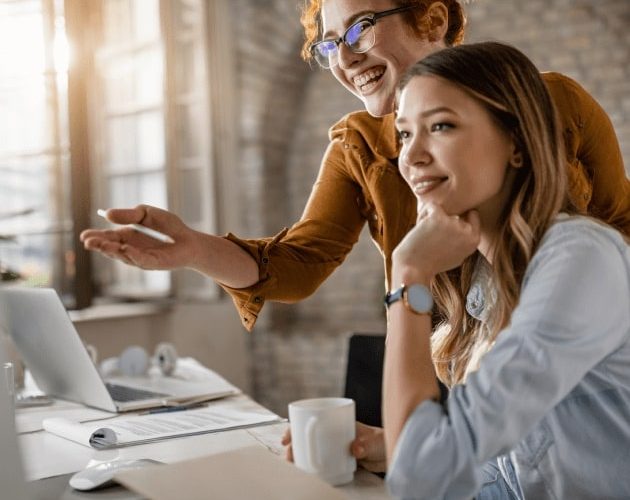As young inventors or entrepreneurs, we all can dream of creating the next big thing. But creating a brand new product is not all butterflies and rainbows – there are steps to follow that will set you up on the right path. One of those critical steps is designing a prototype.
Now, your next step is to learn how to make a prototype. Let us be your ultimate guide here.
We’ll teach you what product prototyping is, what its benefits are, and show you the 10 steps you must take to create a prototype.
So, is product prototyping easier said than done or is it not as tough as you imagined?
Grab a cup of coffee, and let’s dive right in.
What is product prototyping?
Before we teach you how to make a prototype, let us tell you what it means. In simple words, product prototyping is the process of creating a preliminary version or model of a product before you hit mass production or launch.
The goal of prototyping is to help you test and refine your product until you find the perfect version. You can use it to gather feedback from customers, in which case reality is better than theory.
Whether you’re creating a digital product, a new magic mop, or shoes that can make you walk 250% faster, you have to create a prototype first. While this process might not look the same for everyone, the goal and gist stay the same.
What if you think that you’ve already got the perfect sketches for a product and that creating a prototype won’t change your decisions? Let’s talk about the benefits of prototyping to help you safeguard your success.
What are the benefits of prototyping?
When it comes to turning your ideas into reality, prototyping is your secret weapon. In the fast-paced world of business, having a tangible representation of your product before it hits the market can make all the difference.
Let us make it simple and list the 3 main benefits of prototyping you’re bound to get:
- Gain invaluable user feedback: With a physical product, you’ll be able to truly grasp what your customers think about your product, what they want from it, and what it’s missing.
- Save time and money: Testing a product means lowering your risk of failure. Who doesn’t want to save their precious resources from loss?
- Make the perfect product through iterations: With every change you make to your prototype, you’ll come closer to building the ideal version. You might make 10-100 iterations, but you definitely won’t risk launching a bad product into the market.
So, are you ready to learn how to make a prototype? Let us unlock our 10 steps to a successful product prototype.
How to make a prototype in 10 steps
Now, let’s get to the most actionable part of our guide on how to make a prototype. From thorough research and sketches to rapid prototyping and validation, this process is comprehensive, to say the least.
You’ll need to combine the strength of all your team members to finally create a product you’ll be proud to sell.
As you already know, making a product prototype might not look the same for every startup or brand, but here are the 10 general steps you can expect to tackle when making a prototype.

1. Conduct market research
The first step you need to take when learning how to make a prototype is how to do market research. This includes everything there is to know about your target market, customer needs, competitors, and much more.
If you’re new to the market, these steps might take you a while. Gathering insights into your market will be crucial in how you shape your business as a whole.
Here are just a couple of things you stand to gain by conducting market research:
- Understand your demand
- Recognize market trends
- Discover and identify your actual customers
- Uncover potential issues and gaps in the market
After all of this, you’ll be ready to craft a strategy that’ll blow your competitors out of the water and make your customers fall in love with your product. Most of all, you’ll have completed the first step of making a product prototype.
2. Define design requirements
Your second step in learning how to make a prototype is defining design requirements. This covers both the functionality and aesthetic sides of the product. Just to make it a bit easier for you, here are some questions you’ll need to answer for yourself:
- What are the primary and secondary features of your prototype?
- What will be the performance criteria you set for your prototype?
- What materials will you use?
- What is the physical sizing of your product?
- What colors will you use?
These requirements you set will be the base and guiding framework for your functional prototype, so make them count.
3. Sketch multiple concepts
Developing a prototype is not an automatic process – it’s highly creative, and you’ll need to manage many things at once. This includes juggling multiple design ideas until you choose your perfect variant.
Just like you take numerous pictures and choose the best one, you’ll need to design multiple product variations to find the one people like the most.
Here are some factors you’ll need to consider when choosing between design options:
- Usability: The user experience is a game-changer when it comes to product design. Does it fulfill its purpose? If yes, then the design can move on to the next stage.
- Aesthetics: While usability is a priority for customers, they still might not be willing to purchase an odd-looking product. So, make sure your product is easy on the eyes.
- Manufacturability: As beautiful and usable a product can be, it will be null and void if you can’t efficiently manufacture it. Make sure that you design something that can be created.
When you’re narrowing down your design options, ask your team members to vote on their favorites, then rate them based on feasibility, market appeal, and other factors. After you land on a couple of winners, you’ll need to conduct a feasibility analysis.
4. Conduct feasibility analysis
On the 4th step of learning how to make a prototype, you’ll need to narrow down the design options you created for your prototype. This means you’ll need to assess their technical viability and consider their manufacturing requirements.
All of this is done to understand which design is most feasible for your prototyping process. Here are some factors you’ll need to consider:
- Material availability
- Costs
- Timelines
- Manufacturing process difficulties
- Legal feasibility
These are only a couple of factors that can sway your decision one way or the other. After conducting your feasibility analysis, you’ll have a clear picture of which idea is best for your brand to tackle.
5. Create a virtual prototype
Before you create a physical prototype, you’ll need to create a virtual version. This way, you can switch from sketches to 3D models and be able to visualize your creation a bit better.
Luckily, technology today allows us to do unthinkable things. We recommend using CAD software to visualize and refine your design digitally in the easiest way possible.
Such software can even let you test your product’s functionality and make the required changes. Even if you eliminate the need for one more iteration of a physical prototype, it’ll still be a time- and money-saver.
Once you have your virtual prototype, you can start gathering feedback from anyone you like, including market experts, your team members, and even customers.
After you fine-tune your digital prototype variation, it’ll be time to start creating the physical prototypes!
6. Rapid prototyping
Now that you have your virtual prototype finalized, it’s time to get down to business! This is when your journey of learning how to make a prototype culminates. So, the 6th step we have is rapid prototyping. This essentially means utilizing 3D printing, laser cutting, or similar methods to build physical prototypes quickly.
Rapid prototyping isn’t only cost-efficient, but, as the name suggests, it is time efficient as well!
If you’re new to rapid prototyping and prototyping altogether, we recommend consulting with an expert. Find a friend who owns a 3D printer or apply to a startup accelerator where you’ll get the required resources to do rapid prototyping.
Iterate on the design as many times as necessary to fix any issues or apply improvements identified during the prototyping process. When you land on a version you like a lot, it’ll be time to test and validate your prototype.
7. Test and validate
As we pass the mid-way mark of our guide on how to make a prototype, it’s time to talk about testing and validation. Ultimately, this is the step where you ensure that the prototype meets functionality and performance requirements.
To conduct thorough tests and prototype validation, you’ll need to focus on a couple of aspects, including functionality, usability, and stress testing.
If you’re still unsure why testing and validating your prototype is important, consider the following benefits:
- Discover issues at a stage where you can easily change them
- Reduce your risk of failure
- Save time and money in the long run
- Find your product-market fit
Your tests are bound to lead to a couple of points for improvement, and this is when you’ll start to seek feedback, make adjustments, and iterate again.
8. Seek feedback and iterate
After you internally test and validate your product, it’ll be time to take it to the people and seek as much feedback as possible. Gather input from your potential users, industry experts, and other credible sources. This will be vital to the success of your business.
Once you have gathered the invaluable feedback that your users can share, it’ll be time to refine your design based on your learnings. Next, take your refined product, and repeat the whole process again.
Continuous refinement through iterations is key to taking your final product to a successful launch.
9. Build a production-ready prototype
Every iteration of your prototype will bring you closer to the final version of your product. Once you feel like you’ve landed on that version, it’ll be time to move on to building a production-ready prototype.
While 3D printers might not build a high-quality product, they can still help you gather feedback. However, after you’ve finalized your design, selected manufacturing methods, and sourced your materials, you’ll be able to finally build the real thing.
Now, prototype manufacturing means that you’ll build a product that’s very close to your final product in terms of design, functionality, and materials. After all your hard work, sweat, and tears, you’ll finally be able to hold it in your hands and admire its beauty.
Last but not least, you’ll need to collaborate with manufacturers to make sure the prototype is ready for mass production.
10. Documentation and communication
The last step in our guide on how to make a prototype is documentation and communication. This is when you’ve had your fun, and it’s time to do some paperwork and talk about the technical side of things. So, you’ll need to document the process, including each and every decision you made.
Why do you need to do this? Well, there is a lot to be learned from each and every piece of data that you gather. This is why having a clear record of each design iteration, test, result, and modification can be a game-changer. Who knows, you might (definitely will) need it during your future endeavors and scaling processes.
Last but not least, you’ll need to effectively communicate all of this info with your stakeholders, including investors and potential users.
Be as transparent as you can with your customers – it will make them love you and they’ll start to get excited for your product’s launch.
So, there you have it folks – those were our 10 steps on how to get a prototype made. But wait, there’s more! We want to fully equip you to handle your product prototyping process on your own, so here are 6 extra tips from us to you.
6 extra tips for making a successful prototype
Now that we’ve covered all 10 steps you need to learn how to make a prototype, let’s talk about some best practices. We’ve gathered 6 extra tips to make your success even more viable, so let’s just jump right in.
- Study existing solutions for insights
Before learning how to make a prototype, you need to learn what comes before it – it’s preparation and tons of research. You need to scour the market for existing solutions and analyze them from A to Z. Pinpoint what works and what doesn’t.
This will help you deeper understand not only your competitors but your customers and your product.
What is missing?
What can you do better?
What does the customer need and what do they not care about?
- Consult field experts for guidance
If you’re diving head-first into prototype development, you’re going to need some help. That’s why it’s critical to find mentors who can guide you through this whole process. From industry experts to business consultants, you’ll need all the help you can get.
Build your network, attend events where you’ll meet like-minded people, join communities, and you’ll be better off at all times.
- Prototype incrementally, start simple and evolve gradually
Iterations exist for a reason. Did you know that the N1 rule of A/B testing is to only test 1 thing at a time? This is so that you can actually measure the impact of only that factor. The same applies to your prototype iterations.
Learn how to prioritize your features. Test the core functionality first, then move on to the smaller details. At the end of the day, you need to make sure that every iteration is better than the last one.
- Embrace user feedback for improvement
In the stage of prototype validation, user feedback will be your bread and butter. This is where the majority of your improvement areas will arise. After all, the product is being built for them, so it has to make sense for them.
Being user-centric will only lead your startup to success.
- Adapt, experiment, and learn from mistakes
When learning how to make a prototype, remember that the process requires flexibility. Being adaptable is one of the keys to success here. You cannot be protective of your creation. We get it, it’s your baby, but you need to be open to adjustments.
Where there is failure, there is growth. You need to make mistakes so that you can learn from them. So, in this spirit, embrace change and create a team that has the bigger picture in mind.
- Consider outsourcing to a prototyping agency to maximize the benefits
Lastly, if all else fails, you may want to stop trying to learn how to make a prototype and simply trust the pros. Some projects need that expert touch and advanced tech to function.
This doesn’t have to mean anything bad for your business. Instead, you’ll have time to focus on other aspects of your business and grow with a bigger force.
BONUS: 6 side things you should take care of when making a prototype
Aside from our main 10 steps, there are 6 side things you should handle when learning how to make a prototype. These are more technical aspects of things, but still just as important. So, here’s what you need to do before you can consider your prototype complete.
Shield your brilliance: Consult an IP lawyer to safeguard your ideas
First things first, when you create a brand new product, you need to think about patents, trademarks, and copyrights. After all, you don’t want anyone to steal your idea, right? So, consult an IP lawyer and you’ll sleep better at night.
Keep secrets safe: Use non-disclosure agreements for sensitive info
When learning how to make a prototype, you’ll realize that you can’t do it all alone. Now, of course, loyalty in a team is vital, but from a business perspective, NDAs are almost mandatory. They’ll simply make sure that no sensitive info gets out, and if it does, you’ll be protected.
Optimize for efficiency: Trim costs, boost productivity
Budgeting is somewhat of an art. Regardless of whether or not you have funding, saving a penny here and a penny there is just good sense. And this process doesn’t mean that you’ll have to sacrifice on quality. On the contrary, you’ll be able to streamline your workflows and improve your productivity.
Outsource for wins: Maximize benefits with external expertise
Now more than ever, startups and companies are choosing to outsource many functions of the business. It usually brings more value for your money than hiring an in-house specialist. The main areas where you should consider outsourcing are:
- Design and engineering
- Manufacturing
- Marketing
- Testing and validation
- Legal aspects
Protect your genius: Safeguard your intellectual property
After you learn how to make a prototype and consult an IP lawyer, there are other steps you need to take. From implementing internal protocols and educating your team to use best practices and securing digital assets, you need to make sure that your ideas are safe and sound from all 4 sides.
Unleash insights: Ask vital questions post-prototype
When you have your prototype ready and set, it’ll be time to do prototype validation. Here is where you need to learn the art of asking the right questions.
Understand that getting the truth out of customers may be tough. There are such things as leading questions and biased feedback. At the end of the day, you have to make sure to get actual, reliable feedback from your customers.
Conclusion
There you go – here’s how to make a prototype in 10 steps, plus 12 tips on how to make your creation successful. Creating a successful prototype requires a systematic approach and careful consideration of each step. But don’t forget to be creative too!
Remember to always listen to your customers and never be scared to pivot. Give your all to each and every iteration of your prototype as they bring you closer to your final product.
Brainstorm as hard as you can during the creative steps, and consult an IP lawyer to keep your creation safe. A good product has both brilliance and practicality.
Our goal today was to provide you with all the information you need to confidently embark on your own prototyping projects and bring your ideas to life. We wish you the best of luck!




